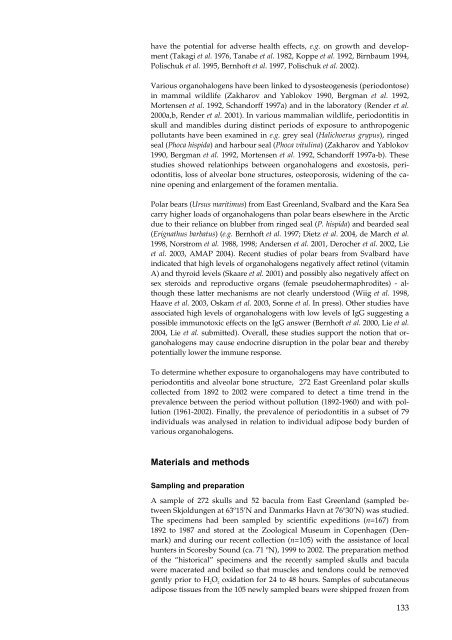Organohalogen concentrations and a gross and histologic ...
Organohalogen concentrations and a gross and histologic ...
Organohalogen concentrations and a gross and histologic ...
Create successful ePaper yourself
Turn your PDF publications into a flip-book with our unique Google optimized e-Paper software.
have the potential for adverse health effects, e.g. on growth <strong>and</strong> development<br />
(Takagi et al. 1976, Tanabe et al. 1982, Koppe et al. 1992, Birnbaum 1994,<br />
Polischuk et al. 1995, Bernhoft et al. 1997, Polischuk et al. 2002).<br />
Various organohalogens have been linked to dysosteogenesis (periodontose)<br />
in mammal wildlife (Zakharov <strong>and</strong> Yablokov 1990, Bergman et al. 1992,<br />
Mortensen et al. 1992, Sch<strong>and</strong>orff 1997a) <strong>and</strong> in the laboratory (Render et al.<br />
2000a,b, Render et al. 2001). In various mammalian wildlife, periodontitis in<br />
skull <strong>and</strong> m<strong>and</strong>ibles during distinct periods of exposure to anthropogenic<br />
pollutants have been examined in e.g. grey seal (Halichoerus grypus), ringed<br />
seal (Phoca hispida) <strong>and</strong> harbour seal (Phoca vitulina) (Zakharov <strong>and</strong> Yablokov<br />
1990, Bergman et al. 1992, Mortensen et al. 1992, Sch<strong>and</strong>orff 1997a-b). These<br />
studies showed relationhips between organohalogens <strong>and</strong> exostosis, periodontitis,<br />
loss of alveolar bone structures, osteoporosis, widening of the canine<br />
opening <strong>and</strong> enlargement of the foramen mentalia.<br />
Polar bears (Ursus maritimus) from East Greenl<strong>and</strong>, Svalbard <strong>and</strong> the Kara Sea<br />
carry higher loads of organohalogens than polar bears elsewhere in the Arctic<br />
due to their reliance on blubber from ringed seal (P. hispida) <strong>and</strong> bearded seal<br />
(Erignathus barbatus) (e.g. Bernhoft et al. 1997; Dietz et al. 2004, de March et al.<br />
1998, Norstrom et al. 1988, 1998; Andersen et al. 2001, Derocher et al. 2002, Lie<br />
et al. 2003, AMAP 2004). Recent studies of polar bears from Svalbard have<br />
indicated that high levels of organohalogens negatively affect retinol (vitamin<br />
A) <strong>and</strong> thyroid levels (Skaare et al. 2001) <strong>and</strong> possibly also negatively affect on<br />
sex steroids <strong>and</strong> reproductive organs (female pseudohermaphrodites) - although<br />
these latter mechanisms are not clearly understood (Wiig et al. 1998,<br />
Haave et al. 2003, Oskam et al. 2003, Sonne et al. In press). Other studies have<br />
associated high levels of organohalogens with low levels of IgG suggesting a<br />
possible immunotoxic effects on the IgG answer (Bernhoft et al. 2000, Lie et al.<br />
2004, Lie et al. submitted). Overall, these studies support the notion that organohalogens<br />
may cause endocrine disruption in the polar bear <strong>and</strong> thereby<br />
potentially lower the immune response.<br />
To determine whether exposure to organohalogens may have contributed to<br />
periodontitis <strong>and</strong> alveolar bone structure, 272 East Greenl<strong>and</strong> polar skulls<br />
collected from 1892 to 2002 were compared to detect a time trend in the<br />
prevalence between the period without pollution (1892-1960) <strong>and</strong> with pollution<br />
(1961-2002). Finally, the prevalence of periodontitis in a subset of 79<br />
individuals was analysed in relation to individual adipose body burden of<br />
various organohalogens.<br />
Materials <strong>and</strong> methods<br />
Sampling <strong>and</strong> preparation<br />
A sample of 272 skulls <strong>and</strong> 52 bacula from East Greenl<strong>and</strong> (sampled between<br />
Skjoldungen at 63º15’N <strong>and</strong> Danmarks Havn at 76º30’N) was studied.<br />
The specimens had been sampled by scientific expeditions (n=167) from<br />
1892 to 1987 <strong>and</strong> stored at the Zoological Museum in Copenhagen (Denmark)<br />
<strong>and</strong> during our recent collection (n=105) with the assistance of local<br />
hunters in Scoresby Sound (ca. 71 ºN), 1999 to 2002. The preparation method<br />
of the “historical” specimens <strong>and</strong> the recently sampled skulls <strong>and</strong> bacula<br />
were macerated <strong>and</strong> boiled so that muscles <strong>and</strong> tendons could be removed<br />
gently prior to H 2 O 2 oxidation for 24 to 48 hours. Samples of subcutaneous<br />
adipose tissues from the 105 newly sampled bears were shipped frozen from<br />
133

















